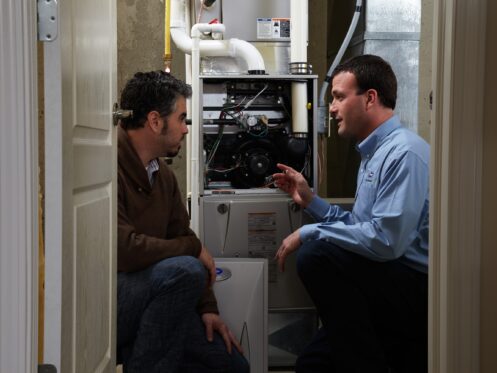Nothing beats a fully functioning HVAC system that controls the temperature and air quality when keeping your house comfortable. The problem is that HVAC systems, like any mechanical system, wear down and become less efficient and effective over time. You should probably update your AC system or heater if you’re experiencing ongoing problems.
1. Increased Energy Bills
Rising energy costs are a telltale indicator that it’s time to replace your HVAC system. As time passes, the heating and cooling equipment will use more energy to keep the home comfortable, increasing energy bills and causing extra wear and tear.
2. You Keep Having to Adjust the Thermostat
If you constantly have to fiddle with the thermostat, several potential causes could exist. A malfunctioning sensor will result in a thermostat that doesn’t accurately read the temperature. A faulty wiring connection will cause intermittent signals, making it necessary to readjust the thermostat several times throughout the day. One of our technicians can inspect the thermostat to tell whether to replace it. Sometimes, the thermostat will be working completely fine, but other malfunctioning HVAC components will cause the necessary adjustments. In this scenario, replacing the whole HVAC system might be best, especially if it’s a broken compressor or heat exchanger.
3. Uneven Heating or Cooling
Inconsistent heating or cooling throughout the house indicates that something is wrong with your HVAC system. You may find that some rooms are consistently much warmer or cooler than others or that certain parts of your house can’t seem to get hot or cold enough. Possible causes include insulation concerns, clogged ductwork or a failing system that cannot circulate air efficiently throughout your house. A complete upgrade may be the only way to ensure effective heating and cooling throughout the home.
4. Poor Indoor Air Quality
A worn-out system won’t be able to filter the air effectively, which might cause indoor air quality issues like allergies or a musty smell. More recent versions include state-of-the-art filtration technologies that enhance air quality. They do this by decreasing the allergens circulating in your house.
5. Strange Noises From the Unit
Warning sounds like banging, clanking or screeching from your HVAC system should prompt you to act. Hearing any of these sounds may be a sign of a broken motor, a loose belt or something blocking airflow. While some noise is inevitable, constant or loud noises may indicate the need to replace the whole furnace or AC.
6. Excessive Dust Buildup in the Home
A house with an inefficient HVAC system will likely experience excessive dust buildup. This happens because the unit will struggle to filter dust and dirt, which can lead to poor air quality and frequent cleaning. If dust settles quickly on furniture and air vents even after cleaning, a new system can help with this problem. Keeping dust to a minimum reduces wear and tear on the heating and cooling equipment. Over time, the reduced wear and dust help the equipment last longer.
7. System Frequently Cycles On and Off
Short cycling occurs when an HVAC system quickly turns on and off over and over. This is usually an indication of a more severe problem. Short cycling might happen if your system is too big for your house or there’s an internal problem, such as a broken thermostat or a blocked filter. Other common causes of short cycling include low refrigerant levels, dirty coils and a malfunctioning compressor. The wasted energy and system wear caused by this problem raise energy expenditures and maintenance frequency. In many cases, it’s best to go ahead and replace the whole setup to restore proper function and efficiency.
8. Age of the HVAC System
After their initial 10–15-year lifespan, systems often begin to degrade and need more frequent servicing. If your system is nearing or beyond this age, consider updating to avoid costly and inconvenient system failures.
9. Poor Airflow Throughout the House
Clogged filters are the most common cause of airflow problems. If you keep the filter changed and still experience airflow issues, it might be time for a new system. You want optimal airflow at all times to ensure even air distribution to enhance indoor comfort levels.
10. System Needs Frequent Repairs
Occasional repairs to a system are expected, but constant maintenance indicates it may be time to upgrade. Frequent repairs will quickly accumulate and may put a strain on your finances. An update will likely save you money since it improves system dependability and decreases repair expenses.
11. Refrigerant Leaks or Low Levels
Recharging refrigerant is not a normal part of owning an air conditioner. You only need to add more refrigerant when there is a leak. Refrigerant leaks make an AC struggle to maintain a steady, cool temperature. This can increase energy bills and cause problems like frozen coils or reduced cooling capacity. If you’ve hired someone to fix a refrigerant leak but it keeps happening, you should consider a complete system upgrade. This will ensure long-term efficiency and reliability.
12. Visible Rust or Corrosion on Parts
Once a system is nearing its end of life, the coils, vents and condenser unit will start showing visible signs of rust or corrosion. Damage from rust and corrosion will reduce the system’s performance or cause it to fail altogether. If you see any of these signs, consider installing a new system.
13. Unusual Odors From Vents
If you notice a burnt or musty smell coming from air vents, this indicates overheating components or mold growth. Because mold grows best in wet conditions, a malfunctioning or leaky HVAC system can exacerbate the problem. When ignored, overheating or mold growth results can be disastrous by increasing fire hazards and health issues. Upgrading the home with a new HVAC system is a great way to improve safety and air quality.
14. Limited or No Maintenance History
Keeping up with routine maintenance is key to avoiding expensive repairs and keeping the HVAC working correctly. Inadequate or nonexistent maintenance on your system is a red flag that it isn’t working as effectively as possible. An update may be your best bet for meeting your home’s heating and cooling demands.
What to Expect During an Upgrade
We will perform several inspections once you decide to upgrade your home’s heating and cooling equipment. First, we will inspect the ductwork, insulation and layout to determine the best size system for your house. HVAC sizing is paramount to energy efficiency and optimal performance. Next, we will inspect the electrical system and ventilation to ensure proper airflow and safety. Once we have all the new equipment in place, we will walk you through how to use it to achieve the best energy savings possible.
Mackey Services is an industry leader who helps people decide when to upgrade their HVAC systems. Our services include repair, installation, and maintenance as well as indoor air quality and smart thermostats to make your system more efficient and convenient. Call Mackey Services today to book reliable HVAC services in Dickinson, TX.





